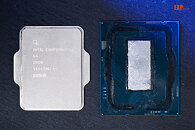- Joined
- Oct 9, 2007
- Messages
- 47,447 (7.50/day)
- Location
- Hyderabad, India
| System Name | RBMK-1000 |
|---|---|
| Processor | AMD Ryzen 7 5700G |
| Motherboard | ASUS ROG Strix B450-E Gaming |
| Cooling | DeepCool Gammax L240 V2 |
| Memory | 2x 8GB G.Skill Sniper X |
| Video Card(s) | Palit GeForce RTX 2080 SUPER GameRock |
| Storage | Western Digital Black NVMe 512GB |
| Display(s) | BenQ 1440p 60 Hz 27-inch |
| Case | Corsair Carbide 100R |
| Audio Device(s) | ASUS SupremeFX S1220A |
| Power Supply | Cooler Master MWE Gold 650W |
| Mouse | ASUS ROG Strix Impact |
| Keyboard | Gamdias Hermes E2 |
| Software | Windows 11 Pro |
An Intel Core "Raptor Lake" engineering sample was de-lidded by Expreview giving us a first look at what will be Intel's last monolithic silicon client processor before the company switches over to chiplets, with its next-generation "Meteor Lake." The chip de-lidded here is the i9-13900, which maxes out the "Raptor Lake-S" die, in featuring all 8 "Raptor Cove" P-cores and 16 "Gracemont" E-cores physically present on the die, along with 36 MB of shared L3 cache, and an iGPU based on the Xe-LP graphics architecture.
The "Raptor Lake-S" silicon is built on the same Intel 7 (10 nm Enhanced SuperFin) silicon fabrication node as "Alder Lake-S." The "Raptor Lake-S" (8P+16E) die measures 23.8 mm x 10.8 mm, or 257 mm² in area, which is 49 mm² more than that of the "Alder Lake-S" (8P+8E) die (around 209 mm²). The larger die area comes from not just the two additional E-core clusters, but also larger L2 caches for the E-core clusters (4 MB vs. 2 MB), and larger L2 caches for the P-cores (2 MB vs. 1.25 MB); besides the larger shared L3 cache (36 MB vs. 30 MB). The "Raptor Cove" P-core itself could be slightly larger than its "Golden Cove" predecessor.

Even with the larger die, there's plenty of vacant fiberglass substrate inside the IHS. Future client sockets such as the LGA1800 have an identical package size to the LGA1700, with the additional pin-count coming from shrinking the "courtyard" in the land-grid (the central empty space). This indicates that future MCM chips such as the "Meteor Lake" have plenty of real-estate on the substrate, and Intel can maintain package-size and cooler-compatibility across several more generations. That said, "Raptor Lake-S" will be a Socket LGA1700 processor, will work with Intel 600-series and upcoming 700-series chipset motherboards; but will likely not be compatible with future LGA1800 platforms.
View at TechPowerUp Main Site | Source
The "Raptor Lake-S" silicon is built on the same Intel 7 (10 nm Enhanced SuperFin) silicon fabrication node as "Alder Lake-S." The "Raptor Lake-S" (8P+16E) die measures 23.8 mm x 10.8 mm, or 257 mm² in area, which is 49 mm² more than that of the "Alder Lake-S" (8P+8E) die (around 209 mm²). The larger die area comes from not just the two additional E-core clusters, but also larger L2 caches for the E-core clusters (4 MB vs. 2 MB), and larger L2 caches for the P-cores (2 MB vs. 1.25 MB); besides the larger shared L3 cache (36 MB vs. 30 MB). The "Raptor Cove" P-core itself could be slightly larger than its "Golden Cove" predecessor.

Even with the larger die, there's plenty of vacant fiberglass substrate inside the IHS. Future client sockets such as the LGA1800 have an identical package size to the LGA1700, with the additional pin-count coming from shrinking the "courtyard" in the land-grid (the central empty space). This indicates that future MCM chips such as the "Meteor Lake" have plenty of real-estate on the substrate, and Intel can maintain package-size and cooler-compatibility across several more generations. That said, "Raptor Lake-S" will be a Socket LGA1700 processor, will work with Intel 600-series and upcoming 700-series chipset motherboards; but will likely not be compatible with future LGA1800 platforms.
View at TechPowerUp Main Site | Source






 ~400W
~400W
